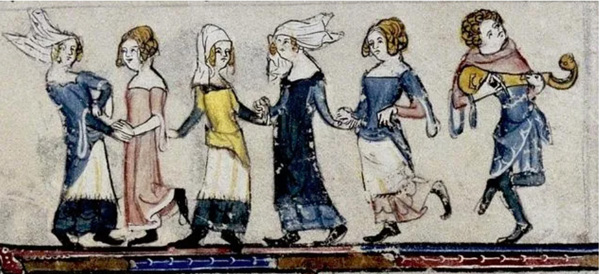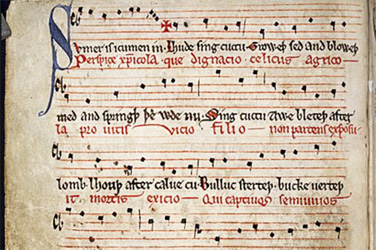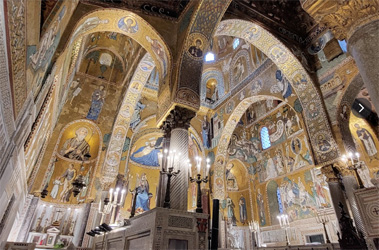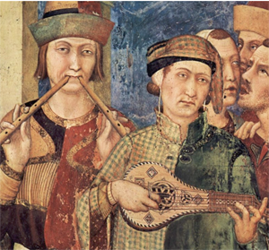

Instrumental Music in the Middle Ages
This is a topic that needs about a thousand pages to cover, but I would like to touch on only a few important concepts, useful in an “authentic” (historically-informed) performance of medieval music.
 The time we call the Middle Ages is a long period from about 400 CE (the fall of the Roman Empire) to about 1500 CE. Authentic performances of non-liturgical Medieval music, that is, attempts to reproduce the instrumental music that was actually heard during this long period is challenging for several reasons. (Vocal music has completely different issues to solve).
The time we call the Middle Ages is a long period from about 400 CE (the fall of the Roman Empire) to about 1500 CE. Authentic performances of non-liturgical Medieval music, that is, attempts to reproduce the instrumental music that was actually heard during this long period is challenging for several reasons. (Vocal music has completely different issues to solve).
The first is that modern ears are attuned to a much, much wider palette of tone colors, dynamics, and the expressive power of complex chords than people’s ears in the Middle Ages. We listen with an expectation of texture, mood and melodic development based on our experience with the renaissance/baroque/rococo/classical/romantic and modern periods.
The second issue is that instruments during that period were much more limited in tone color and range than instruments during the later Renaissance. The recorder, for instance, only existed in what we now refer to as a soprano/alto range. Renaissance and later recorders had a conical bore which made it possible to build recorders in many larger sizes. The four surviving recorders from the Middle Ages have a cylindrical bore which prevented this later development. There is no medieval art that clearly shows a recorder larger than a soprano/alto size. So the Medieval ear did not hear the deeper tones from tenor, bass, and larger recorders that we are used to.
 Medieval stringed instruments were primitive by Renaissance standards. In earliest period, c.400 -600CE, a musician not only made his own instruments but often had to make his own strings. The most common stringed instrument used by the jongleurs, troubadours, or minstrels was the harp, not the lute. The lute was not introduced into Europe through Spain by the Andalusian Muslims until the thirteenth century. It appeared in Sicily in the twelfth century. Lutes in the form of the Oud were brought back to Europe by crusaders from the Near East somewhat earlier, but were widely regarded as souvenirs since the oriental music would have sounded very foreign to European ears.
Medieval stringed instruments were primitive by Renaissance standards. In earliest period, c.400 -600CE, a musician not only made his own instruments but often had to make his own strings. The most common stringed instrument used by the jongleurs, troubadours, or minstrels was the harp, not the lute. The lute was not introduced into Europe through Spain by the Andalusian Muslims until the thirteenth century. It appeared in Sicily in the twelfth century. Lutes in the form of the Oud were brought back to Europe by crusaders from the Near East somewhat earlier, but were widely regarded as souvenirs since the oriental music would have sounded very foreign to European ears.
In Italy, 14th-century giullari-poets played the lute while in France the musicians favored the harp, gittern, and vielle. The lute was well-known in Florence in Dante’s time (1265-1321) and shows up in his Divine Comedy. Petrarch (1304-1374) played the lute, which he called a “lyre”.
 Besides lutes, other instruments in Sicily in the 12th century (as depicted in the Capella Palatina in Palermo, built in 1170) included gitterns, drums, pandores, rababs, qanuns (psalteries) clappers and small vielles or viols. (Click on photo) Ideally, modern musicians would try to match the period of the piece with its location and choose instruments that would have been available to the musicians at that time and place. Of course, that depends on the instruments that are available and isn't always practical. Not every group, who may already have a nice selection of Renaissance and Baroque instruments, can afford to equip themselves with a complete set of Medieval instruments, which are not only expensive but difficult to find. Concessions have to be made.
Besides lutes, other instruments in Sicily in the 12th century (as depicted in the Capella Palatina in Palermo, built in 1170) included gitterns, drums, pandores, rababs, qanuns (psalteries) clappers and small vielles or viols. (Click on photo) Ideally, modern musicians would try to match the period of the piece with its location and choose instruments that would have been available to the musicians at that time and place. Of course, that depends on the instruments that are available and isn't always practical. Not every group, who may already have a nice selection of Renaissance and Baroque instruments, can afford to equip themselves with a complete set of Medieval instruments, which are not only expensive but difficult to find. Concessions have to be made.
The early music revival was well underway by 1950, and was fully established by the end of the 1970’s. Hundreds of recordings were produced, most using a mixture of later Renaissance and even Baroque instruments, none of which existed in that form during the Middle Ages. One exception was Thomas Binkley, who made made ground-breaking recordings with the Studio der Frühen Musik using Ouds and authentic copies of historical instruments. For others, the temptation to add a wider palette of deeper and richer tone colors with Renaissance and Baroque instruments was just too much to resist.
 Ultimately, the challenge of performers of Medieval music on authentically re-constructed instruments is how to engage the modern audience without sounding too simple or primitive, how to make the music expressive, how to bring it to life in ways that satisfy the ear of the modern listener. (One way is to add a singer. Vocalists always raise the interest level exponentially.)
Ultimately, the challenge of performers of Medieval music on authentically re-constructed instruments is how to engage the modern audience without sounding too simple or primitive, how to make the music expressive, how to bring it to life in ways that satisfy the ear of the modern listener. (One way is to add a singer. Vocalists always raise the interest level exponentially.)
It’s hard to imagine that players from different towns would get together and their instruments would not only share the same tuning system (certainly not equal temperament) but actually be in tune with each other to the extent that is demanded by modern classically-trained musicians. To satisfy a modern audience, players have to share similar temperaments (tuning systems) and be tuned to the same pitch (usually A=440, a pitch level that was only established in 1936). Pitch in the Middle Ages varied widely from player to player, even in the same town.
One of the reasons the lute ruled Europe for 400 years is that the instrument is capable of very fine, precise tuning (in different temperaments) and virtuosos rose who could transport the listeners to a kind of ecstasy. The lute's ravishing tone in the hands of a good player made it the most esteemed and admired of all musical instruments. By the time of the Renaissance, the fame of great players spread throughout Europe and influenced musical styles everywhere. Composers created a solo repertoire that was refined, expressive and extraordinarily rich in compositional techniques, melodies, and even symbolism.
 The Medieval lute had fewer strings the the Renaissance lute and was at first used primarily for monophonic (single-line) passages played with a quill or plectrum. It wasn’t long before Medieval players began adding extra notes to make simple chords. Playing a three-note chord with a plectrum and playing all three notes simultaneously (not arpeggiated) has been done successfully by modern players, but it is not without challenges. In the late 15th century, players gave up the plectrum and just used their fingers to make chords. Much easier! But it’s also a very different sound. Finger plucking is done without nail and is softer and mellower sounding than playing with a pick. Played with a pick, individual notes stand out sharply when accompanied by other instruments like a drum. Medieval lute music played with a pick gives an entirely different feeling than the same passage played with the fingers. It hearkens back to the Middle Eastern origins of the lute — the Oud. Instead of a French or English court, one thinks of the Alhambra or one the great Islamic palaces in Spain. So much non-liturgical Medieval music in Europe had ties to Arabic, Persian, and Byzantine influence. The harmonic and rhythmic seeds are there and show up in the improvisations that the Islamic world introduced to Europe.
The Medieval lute had fewer strings the the Renaissance lute and was at first used primarily for monophonic (single-line) passages played with a quill or plectrum. It wasn’t long before Medieval players began adding extra notes to make simple chords. Playing a three-note chord with a plectrum and playing all three notes simultaneously (not arpeggiated) has been done successfully by modern players, but it is not without challenges. In the late 15th century, players gave up the plectrum and just used their fingers to make chords. Much easier! But it’s also a very different sound. Finger plucking is done without nail and is softer and mellower sounding than playing with a pick. Played with a pick, individual notes stand out sharply when accompanied by other instruments like a drum. Medieval lute music played with a pick gives an entirely different feeling than the same passage played with the fingers. It hearkens back to the Middle Eastern origins of the lute — the Oud. Instead of a French or English court, one thinks of the Alhambra or one the great Islamic palaces in Spain. So much non-liturgical Medieval music in Europe had ties to Arabic, Persian, and Byzantine influence. The harmonic and rhythmic seeds are there and show up in the improvisations that the Islamic world introduced to Europe.